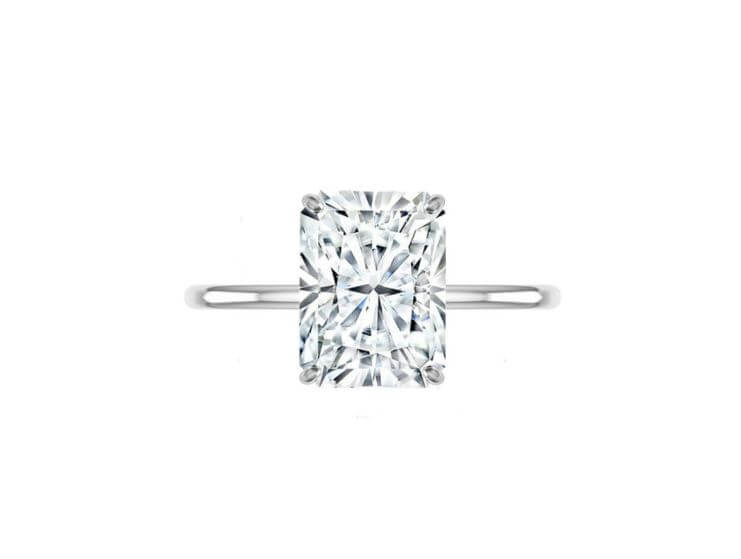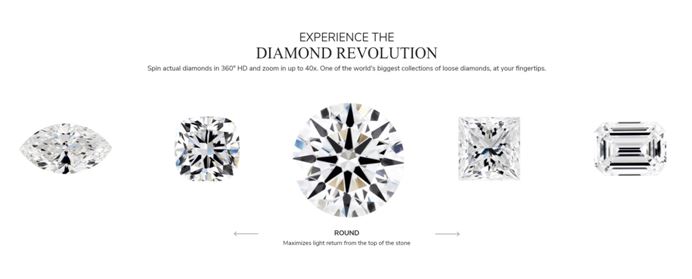Diamonds are the most precious materials in the world. They are often used as a gem in jewelry and are subject to massive applications in the industrial sector where they could function as abrasive for polishing stones, cutting glass and could even be utilized as a component for electrical appliances. Based on the nature of extraction and processing, diamonds often come in different shapes and sizes hence the major method of distinguishing them is through their shape or cut. Diamonds in a lot of cases can be classified based as Round, Princess, Radiant, Marquise, Pear, Oval, Emerald, Cushion, Asscher and Heart. The best description for the radiant cut is that it is a combination of different shapes of diamonds to provide a rectangular look with cropped corners. The cropped corners being the major difference between it and the princess cut both of which share a striking resemblance. In many cases, radiant-cut diamonds have between 53 and 70 facets and these features ensure it is shiny and sparkle.
The exquisite square cut pattern of the Radiant cut is predominantly applicable to its edges which are essentially the crown and pavilion of the gem. This design is the source of the glittery and shiny nature of the gem. Upon closer introspection, one noticeable feature of the Radiant cut is that it seems to share some features of other diamond cuts/shapes. In fact, it is safe to describe the Radiant cut diamonds as a love child of different diamonds shapes because it combines the features of many of them. For instance, aside from the fact that it already looks like the Princess cut diamond due to the cut, it also carries the shape of an emerald cut diamond and sparkle and glamour of a round cut diamond. It shares the looks of an Emerald but looks more pristine and brilliance to look at and in terms of glitzy nature, it grafts the glitzy and glamorous looks of the princess cut. This perhaps explains the preference by many for this particular diamond cut to be grafted into their wedding rings and other fashion accessories. Radiant cut diamonds experienced a surge in acceptance and patronage in the preceding years after it was launched especially for those that were seeking alternatives for the princess and cushion cut.
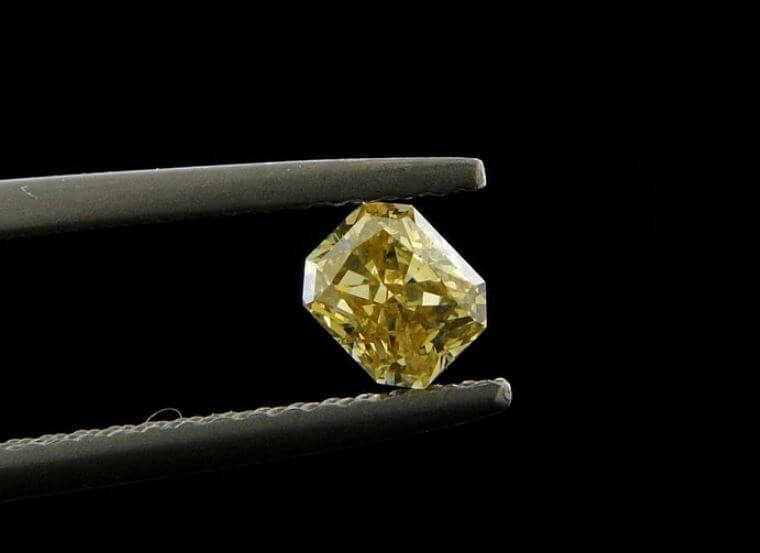
History of Radiant Cut Diamond
The Radiant cut diamond is the brainchild of Henry Grossbard who worked with the Radiant Cut Diamond Company (RCDC) in the year 1977. Grossbard like many people of his time had to emigrate due to the events of the world war. He relocated to New York after World War II where he initially worked as an intern with a diamantaire. This gave him the impetus to study the diamond trade and try to create his own style and infuse his approach into it. He had a noble saying by which he patterned most of his activities. He believed “An experienced craftsman can look into a rough stone and see the finished diamond.” This helped him in his attempt at innovating a new diamond shape. Looking to invent an option to the emerald cut, he wanted to expand the Diamond options from which jewelers can choose from hence he curated a new shape which was to be later known as the radiant cut diamonds. Leveraging on an experience spanning about three decades, Grossbard was able to identify the best qualities of the Emerald and the Round and blend them together to achieve a unique blend of a diamond. In order to achieve his plans of bringing out a diamond blend that will exude maximum brilliance unrivalled by its predecessors he adopted a strategy of combining the ‘step cut’ element that is present in the emerald cut diamond together with the ‘light-reflective’ features from the round brilliant cut and together this generated the radiant cut diamonds. This brilliant experiment still resounds loudly till date in the world of jewelry. The shape he settled for was the square/rectangular shape.
Based on the fact that there were already assorted diamond shapes in the market already, a new diamond cut entering to the market must, therefore, reflect light perhaps in a more refined and exquisite way for it to gain momentum and public appreciation. This is exactly has was achieved with the Radiant cut diamond as it reflects light quite brightly and this has been one of the factors that have been responsible for its popularity since the time it was created in 1977 until now. Regardless of your taste in Diamonds, whatever your preference, the Radiant cut offers a bit of appeal in some way that very few others can possibly offer and this is not a form of bluffing or exaggeration. If you are a round cut diamond aficionado due to its brilliance or if you are a fan of Asscher or Emerald cut diamonds for their distinct glitzy look, chances are that the Radiant will give you the ultimate satisfaction to your every desire in Diamond jewelry and this is why it is almost impossible to ignore. The multiple facets grafted into the jewelry already ensure that it brings out the beauty of the gem and this is a testament to the brilliance of the curator of this Diamond.
Recognizing the Radiant cut diamond can be a little bit tricky since it looks like a few other diamonds cut out there. They may look like a square at some times and they may also attain the looks of a rectangle upon closer introspection albeit with the corners well-trimmed. It is noteworthy to state that a lot has changed since the inception of the Radiant cut diamond even as a lot of variants have been introduced into the market of this particular type of diamond. Firstly, since diamonds are identified by their cut, there are diverse self-professed diamond cutters all around with diverse expertise and know-how in the art of cutting jewelry and not all have been quite able to master the exact dimensions of the Radiant cut as outlined by Grossbard. Identifying the Grossbard original cut Radiant diamond is by no means a negligible task but the best approach to ensuring you get the right diamond is by obtaining the certificate which would also come with authentication. This is the noblest and ingenious way of identifying Grossbard’s ‘Original Radiant Cut’.
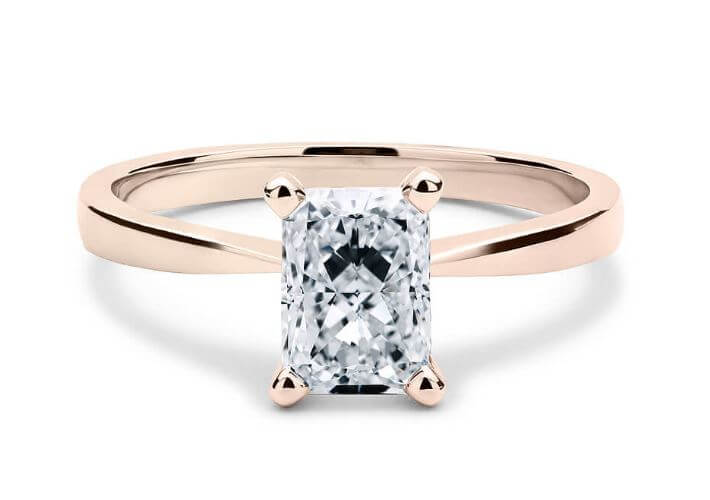
Importance of Radiant Shaped Diamond
For the radiant shaped diamond to have enjoyed the spotlight for several decades there must be something so special about it. It is clearly not the only cut size for diamonds but it is probably the most popular by some margin. Here are some of the reasons behind the massive appeal of the Radiant Cut;
- It contains extra facets that are helpful in concealing any unforeseen flaw in the diamond after it has been fully processed hence giving it a stronger clarity and appeal that could potentially improve its sale.
- The brilliance of Radiant cut diamond is undeniable and this comes with the added advantage of a brighter color making it look stronger than the other diamond cuts such as the princess cut.
- The Radiant cut looks a lot like the princess cut and because they don’t have the delicate corners of the princess cut, Radiant cut diamonds are more durable and may be more suitable for an active lifestyle.
- The radiant cut is possibly the most effective approach to maximizing carats because the cut style itself is well proportioned thereby making it maximize the diamond carats while at the same time eliminating the excess weight beneath the surface of the stone.
Cut Diamond Analysis
At every occasion, before making a decision on purchasing this diamond cut it is expedient to consider the optimum color and clarity grading involved in the product. The essence of this is wrapped behind the idea that the presence of large facets in the Radiant cut diamond will intrinsically reflect the imperfections and inclusions hidden within the stone. The radiant cut is most ideal for brightly colored diamonds because the shape helps to accentuate the colors of the diamonds better than any other shape and apart from this they also preserve the often rough nature of the stone that is morphed into a diamond. The H or I diamond color rating are the most suitable colors to choose from because they show more color than the other color types. One more thing about the radiant cut is that apart from its other tantalizing features, one feature that trumps every other feature and endears it to many jewelry enthusiasts is the pricing because they offer the best diamond quality per dollar spent.
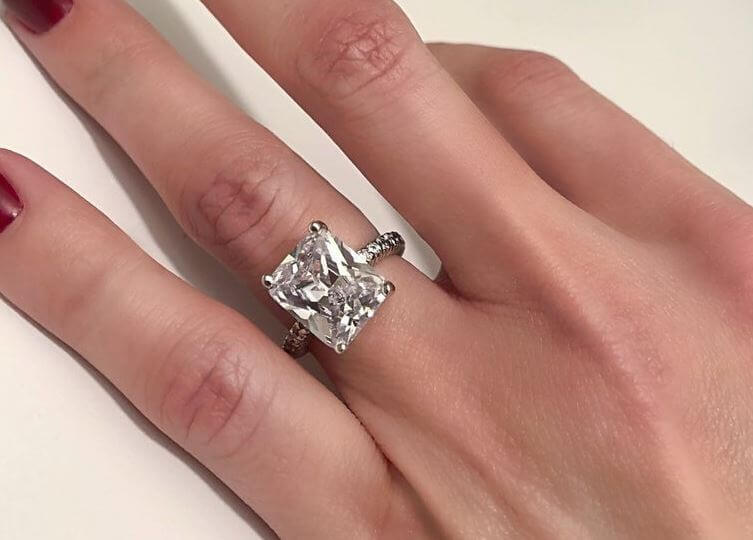
Cut Analysis of Radiant Cut Diamond
| Depth % Poor/Far: <52 or >80 / 52-80 Good: 57-59 / 71-74.5 Very Good: 58.8-70/67-70.1 Excellent: 61.3-67 | Table % Poor/Fair: <50 or >80/50-52.5 or 75.5-80 Good: 53-57/74 Very Good: 58-61/71 Excellent: 62-70 |
| Culet Poor/Fair: Large/Very Large Good: Medium Very Good: None/Very Small Excellent: None | Girdle Poor/Fair: Ex. Thin – Ex. Thick Good: Very thin – thick Very Good: Very thin – slightly thick Excellent: Very thin – slightly thick |
| Length to Width Ratio for Rectangular Cut Poor/Fair: <1.08 or >1.41/1.07-1.08 Good: 1.09-1.13/1.37-1.41 Very Good: 1.14-1.20/1.32-1.36 Excellent: 1.20-1.31 | Length to Width Ratio for Square Cut Poor/Fair: >1.09 /1.07-1.09 Good: 1.05-1.06 Very Good: 1.00-1.04 Excellent: 1.00-1.04 |
Diamonds are produced from stone which is mined under stringent conditions and as such go through a complex process of purification before they can become glitzy and glamorous. Depending on the processes undertaken in the extraction of the diamonds, the level of clarity may vary; however, it is expedient that every radiant diamond is clear. The clarity in itself is a somewhat ambiguous term to describe because the concept of clarity is subjective. Just as it is often said that ‘beauty is in the eye of the beholder’, clarity is also a feature that is subjective as it could vary from one to another. Radiant cut diamonds come with different levels of clarity, make sure to select those with the level of clarity most appropriate for your taste. Although the level of clarity may differ clarity above SI2 (GIA standards) is known to be appropriate for use!
It is not enough to speak about Radiant cut diamonds without touching on the similarity that exists between it and the cushion cut diamonds because they intrinsically share some similar and somewhat confusing features. Identifying both the similarities and the differences between the two will help to avoid confusion when faced with the two. Both Radiant and Cushion cut diamonds possess trimmed corners for increased stability but Cushion cut diamonds will have more rounded edges than the distinct cut even though the latter possess distinct edges. Both of the two categories provide intensive brilliance and strong fire qualities which makes them shine brightly especially when under illumination. Also, another interesting similarity between the two is that Radiant and Cushion Cuts are available in an array of the square to rectangular compositions. The main difference between the two is that Cushion Cuts are majorly purchased with a length to width ratio of 1.0-1.09, which shows that they have a more squared shape as compared to Radiant cut diamonds.
Clarity by Carat
According to the GIA, clarity of diamonds is rated on the following criteria;
- IF– Internally Flawless
- VVS1– Very Very Small Inclusions
- VVS2– Very Very Small Inclusions
- VS1– Very Small Inclusions
- VS2– Very Small Inclusions
- SI1– Small Inclusions
- SI2– Small Inclusions
- I1– Inclusions
- I2– Inclusions
Accordingly, each of the specifications listed above is not applicable to every category of a diamond. There is a range of clarity that suits every diamond depending on the size of the carat. The analysis of this is contained in the table below;
| 1.0 – 2.0 Carat Poor/Fair: SI2-I1 / >I1 Good: SI1-SI2 Very Good: WS2-VS2 Excellent: FL-VS1 | >2.0 Carat Poor/Fair: >SI2 Good: SI1-SI2 Very Good: VS1-SI1 Excellent: FL-WS2 |
| < 0.50 Carat Poor/Far: I2 / >I2 Good: I1-I2 Very Good: SI1-SI2 Excellent: FL-VS2 | 0.51 – 1.0 Carat Poor/Fair: I2 / >I2 Good: SI2 Very Good: SI1-SI2 Excellent: FL-VS2 |
Guidelines to Follow in Buying Radiant Cut Diamonds
- Fire and brilliance are the most obvious qualities by which diamonds are adjudged by. Radiant cut diamonds just as the name implies are radiant in nature and brilliant to behold. The shape of a radiant cut diamond has at least 70 facets and complete brilliant-cut facet pattern hence endeavor to look out for this prior to making a purchase. It’s important that a purchasing decision is not just made simply on the strength of the radiance of the product alone as other diamond shapes may exude similar features which may seem convincing enough for the undiscerning who may end up paying more for what ought to cost less.
- Make sure you are familiar with both square and rectangular radiant cut diamonds. Educate yourself about the nature of square and rectangular diamonds. The jewelry industry is a massive commercial venture with many vendors only interested in making money and may be willing to compromise the quality of the product they are offering for sale to their clients. In this regard, your understanding of square and rectangular square diamonds however how little would go some way in helping you decipher quality from a mere apparition.
- The length to width ratio is also a defining factor in deciding the exact radiant cut diamond to purchase. The length to width ratio is a defining factor because it defines how glittery the diamond will look. For square-shaped Radiant cut diamond, a length to width ratio of 1-1.05 is great whereas, for the rectangular-shaped variant, a length to width ratio of 1.16-1.3 is rectangular is recommended although this would be ultimately decided by the length of the stone involved.
- While analyzing the cut, look for a total table of 57-69% and a depth of 58-70%. This is another crucial factor but should be taken into consideration. An analysis of the cut is contained in a diagram below.
- Diamonds are costly. However, you can ensure to maximize your outlay on them by maximizing measurements within your preferred diamond cut. For instance, in the event of having a 1.0 carat radiant cut diamond coming with the dimensions of 6.0 x 5.5 mm. If there is a 0.98 carat radiant cut diamond with measurements 6.6 x 5.1 mm, this would be a cheaper option to go for.
- Finally, it is necessary to ensure that you purchase only a radiant cut diamond that is graded by either of the American Gem Society (AGS) or the Gemological Institute of America (GIA). These two bodies operate standard laboratories coupled with an arsenal of highly qualified and experienced staff that is well skilled in the cutting of diamonds. Both organizations are noted for a high ethical standard in their grading system which is reliable. This is one way of ensuring that you purchase only the right diamonds.
